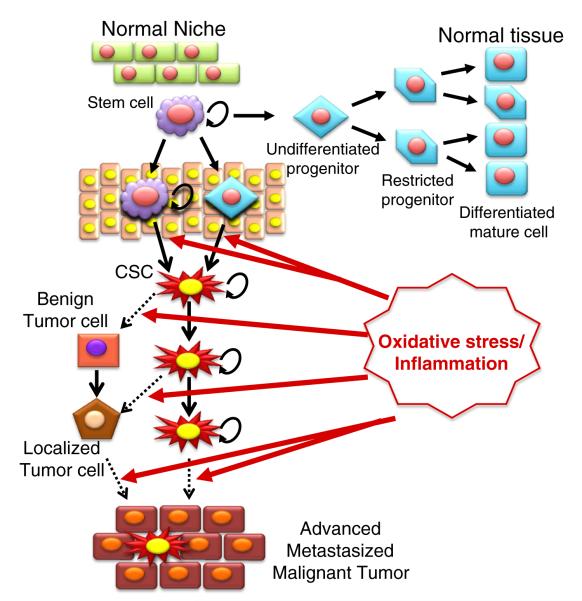Fig. 5.
Potential differences between cancer stem cells (CSCs) and tumor cells. In normal tissues, stem cells maintain self-renewal ability ( ) by interacting with the tissue stroma (niche = green). Within the normal niche, stem cells generate progenitor cells that differentiate into mature cells. During cell division, the replication potential of daughter cells is decreased at each step. If oxidative stress and inflammation stimulate the niche, it could provide stem cells with mutation signals. In response to the mutation signals, stem cell may acquire a tumorigenic capacity and result in CSCs (star-shaped red). Undifferentiated progenitor cells (blue diamond) may also become CSC-like cells driven by the mutation signals. While CSCs proliferate within tumors, they may give a rise to all types of tumor cells at each stage of tumor progression. Benign and localized tumor cells can be potentially (dashed arrow) generated from CSCs. Advanced metastasized and malignant tumor can be formed driven by further mutational signals including additional epigenetic modifications and genetic mutations. In the context of CSC hypothesis, the subset of tumor cells containing CSCs may grow to tumor in a manner that is hierarchical and heterogeneous. In contrast, non-tumorigenic cancer cell may not form tumor successfully.
) by interacting with the tissue stroma (niche = green). Within the normal niche, stem cells generate progenitor cells that differentiate into mature cells. During cell division, the replication potential of daughter cells is decreased at each step. If oxidative stress and inflammation stimulate the niche, it could provide stem cells with mutation signals. In response to the mutation signals, stem cell may acquire a tumorigenic capacity and result in CSCs (star-shaped red). Undifferentiated progenitor cells (blue diamond) may also become CSC-like cells driven by the mutation signals. While CSCs proliferate within tumors, they may give a rise to all types of tumor cells at each stage of tumor progression. Benign and localized tumor cells can be potentially (dashed arrow) generated from CSCs. Advanced metastasized and malignant tumor can be formed driven by further mutational signals including additional epigenetic modifications and genetic mutations. In the context of CSC hypothesis, the subset of tumor cells containing CSCs may grow to tumor in a manner that is hierarchical and heterogeneous. In contrast, non-tumorigenic cancer cell may not form tumor successfully.

